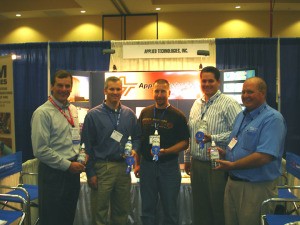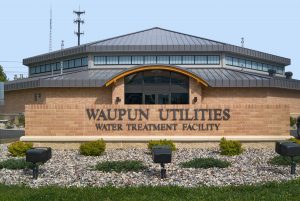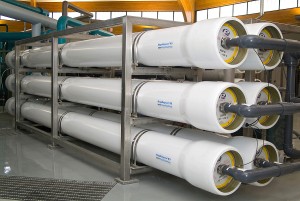Waupun Utilities Implements Reverse Osmosis Technology
Waupun Utilities has provided the City’s population of 10,000 with high quality potable water for more than 70 years. After careful examination of its 20 year future in 2005, the Utility decided it was time to upgrade its existing lime softening treatment plant. Although replacing an “old reliable” system can seem risky, the Utility decided that the risks of such a change were minimal compared to the potential benefits of investing in new technologies.
PLANT HISTORY
The City of Waupun was founded in 1839 along the banks of the south branch of the Rock River, straddling the border of Fond du Lac and Dodge Counties. Waupun Utilities boasts a long, rich history dating back to 1894 when it first began serving the residents of the City of Waupun. In the early 1930s, Utility officials conducted a study of the quality of the water being supplied to residents, giving specific consideration to the removal of iron and a reduction in hardness. The Utility soon constructed a 1 mgd lime softening plant in 1935. This system was utilized for the next 70 years, including a major plant expansion to 2 mgd in 1970.
Typical well water hardness was 320 ppm with an iron concentration of 1.1 ppm. Softened water hardness at the point of entry was approximately 80 ppm. Careful operator attention yielded high quality water for Utility customers.
FEASIBILITY STUDY
In 2005 the Utility embarked on a study of its existing water treatment system, which concluded that the plant had the following deficiencies:
- Most of the plant structures were more than 50 years old, and much of the equipment obsolete from a maintenance standpoint.
- The plant lacked capacity for future demands and critical processes lacked redundancy.
- The process required significant operator attention, 16 hours per day.
- The plant lacked SCADA facilities, so controls, data collection, record keeping, and monitoring were all performed manually.
- Lime sludge disposal is expensive and land intensive, with land availability decreasing.
The Feasibility Study considered the various options available to the Utility, narrowing the field down to three options: lime softening, ion exchange, and reverse osmosis (RO). A preliminary screening of alternatives identified RO as the primary candidate to replace the current lime softening system. RO technology offered several advantages to the Utility:
- Provides absolute barrier against many dissolved contaminants
- Process is easily automated, with less operator attention required
- Eliminates lime sludge disposal
- Consistent product water quality
- Insurance against future unknowns, such as new regulations, changes in well water quality, and the occurrence of additional contaminants.
An economic analysis was prepared comparing the existing lime softening technology with RO. The results indicated that RO was cost competitive with lime softening, producing a 20-year present worth approximately 8% less than that of lime softening. The Study concluded with the recommendation that the Utility replace its current lime softening plant with RO technology.
WATER TREATMENT PRE-DESIGN
A preliminary design effort was initiated in February 2006. Although the initial project cost included capacity for three State-run correctional institutions located in Waupun, discussions with State officials resulted in the decision that capacity for the correctional institutions would not be required of the Utility. The plant would be sized for an initial design maximum day flow of 2.14 mgd.
Onsite pilot testing of RO technology demonstrated the capability of RO technology in treating Waupun well water. The preliminary design phase concluded with a recommended full-scale RO softening system. With this system, the raw water from the five existing wells is pretreated by an iron filter utilizing chlorine and/or permanganate as an oxidant. The filter effluent is split between RO softening and bypass. Pretreatment upstream of RO includes sodium bisulfite to reduce any residual oxidants and a scale inhibitor. Permeate (product water) from the RO would pass through a degas tower to remove carbon dioxide, followed by blending with bypass water. Post treatment chemical feed systems would produce the desired finished water quality standards.
WATER TREATMENT PLANT CONSTRUCTION
Construction of the water treatment plant was bid in November 2006 for $5.9 million, including Utility pre-purchase of RO and iron filter systems. Onsite construction activities began in March 2007 with site preparation for the new plant adjacent to the old treatment building. Start-up activities began in November 2007.
WATER PLANT FULL-SCALE OPERATION
The first full month of RO softening took place in January 2008, while the old plant was taken out of service. Full-scale operations in 2008 are summarized below:
The full-scale plant has operated approximately 15 hours per day to meet demands. Automation and remote monitoring of the plant has allowed the Utility to reduce operations staffing from 16 to about 2 hours per day. The RO permeate yield has been 79%. The target finished water hardness has been achieved by blending 3:1 permeate to iron filter effluent. The overall plant yield (finished water/raw water) has been 81%. Total chemical costs (pre and post treatment) have averaged about $0.24/1,000 gallons. There have been no taste/odor complaints. In fact, Waupun recently won the Taste Test at the 2008 Annual Conference for the Wisconsin Water Association!

Waupun Utilities accepts its WWA award.
For the community of Waupun, the change to new technology has provided a safe, secure water source for the next 20 years. For Waupun Utilities, this new plant reflects its commitment to keeping residents safe, businesses running, and strengthening the future of the City of Waupun.


Leave a Comment